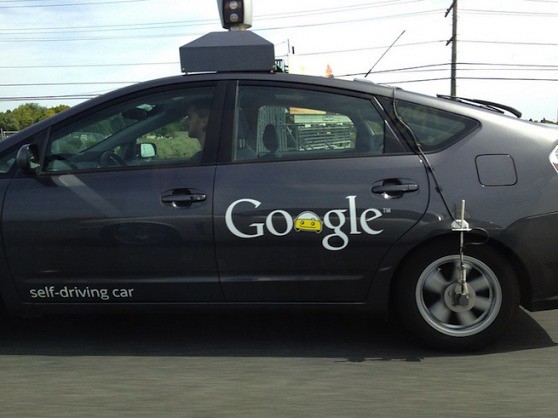Last Monday I noticed a funny looking Google vehicle while driving back home from Palo Alto. 1 It was a white SUV with a big Google logo on the back passenger side door. Traffic was heavy and I didn’t get to look at the vehicle very long. I’ve seen the Google streetview car before – and this was not it. The streetview car has a tall device mounted on the roof with what appears to be four cameras pointing forward, right, left, and back. The vehicle I saw last Monday had a device the size of a small toaster mounted to the roof with four white pipes – and it was spinning very fast.
My guess was this was the Google self-driving car. When I saw this article the following day, picturing the exact vehicle I saw, I was certain.
I have to admit, when I saw this vehicle I was tempted, for just a moment, to drive slightly recklessly and unpredictably to see what Google’s vehicle would do. 2
My superego won out over my id, and I just observed the progress of the Google self-driving vehicle. I wish I had seen the vehicle earlier so that I could have observed more of the vehicle’s behavior from behind it. Here’s what I saw:
- I was in the #3 lane on I-680 North and the Google self-driving vehicle34 was in the #2 lane. Traffic was heavy during the late-afternoon early-evening commute and even though they were in a faster lane, we were probably both going no more than about 35 MPH. 5 6
- They must have left at least at least 5 car lengths worth of traveling distance in front of them.
- I didn’t see them switch lanes – except to take an exit.
- Interestingly, with the ebb and flow of traffic, the Google vehicle was at times far behind me and even a little ahead of me.
- Even though Google as a corporation is a person, and Google was likely present in that vehicle, it did not drive in the HOV/carpool lane.
If Google can drive for 300,000 miles without an accident, including travel in heavy traffic, I suppose there’s a few lessons we can learn:
- The ebb and flow of heavy traffic is enough to basically normalize any efforts to “get ahead,” so you might as well drive as slowly, conservatively, and with as much following distance as Google
- When traffic is congested, it might help to be in a lane farthest from the on/off ramps7
- Always carry two backup passenger/drivers in your vehicle
- Photo courtesy of Saad Faruque [↩]
- My guess – reduce my website’s PageRank and delete my Google+ page. That’s worse than a ding on your driving record, right? [↩]
- Along with it’s two passengers. [↩]
- Prisoners? How do you tell a self-driving vehicle you need to get out and pee? [↩]
- The traffic was so bad that my Android phone, with the Google Maps directions showing me the way back home, displayed the dreaded deep-red path that indicates congested traffic. [↩]
- I mention the Google Maps traffic congestion metric because I assume their vehicle was using the same information I was to make informed driving assessments. [↩]
- Google didn’t have three physical people present, so they couldn’t be in the fastest HOV/carpool lane [↩]

